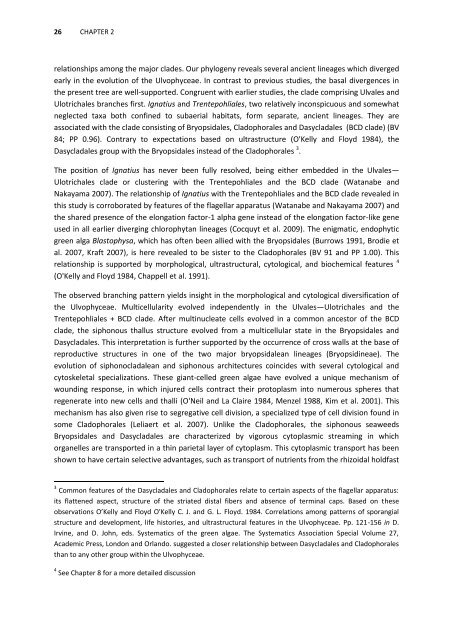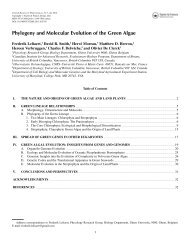Phylogeny and molecular evolution of green algae - Phycology ...
Phylogeny and molecular evolution of green algae - Phycology ...
Phylogeny and molecular evolution of green algae - Phycology ...
You also want an ePaper? Increase the reach of your titles
YUMPU automatically turns print PDFs into web optimized ePapers that Google loves.
26 CHAPTER 2<br />
relationships among the major clades. Our phylogeny reveals several ancient lineages which diverged<br />
early in the <strong>evolution</strong> <strong>of</strong> the Ulvophyceae. In contrast to previous studies, the basal divergences in<br />
the present tree are well-supported. Congruent with earlier studies, the clade comprising Ulvales <strong>and</strong><br />
Ulotrichales branches first. Ignatius <strong>and</strong> Trentepohliales, two relatively inconspicuous <strong>and</strong> somewhat<br />
neglected taxa both confined to subaerial habitats, form separate, ancient lineages. They are<br />
associated with the clade consisting <strong>of</strong> Bryopsidales, Cladophorales <strong>and</strong> Dasycladales (BCD clade) (BV<br />
84; PP 0.96). Contrary to expectations based on ultrastructure (O'Kelly <strong>and</strong> Floyd 1984), the<br />
Dasycladales group with the Bryopsidales instead <strong>of</strong> the Cladophorales 3 .<br />
The position <strong>of</strong> Ignatius has never been fully resolved, being either embedded in the Ulvales—<br />
Ulotrichales clade or clustering with the Trentepohliales <strong>and</strong> the BCD clade (Watanabe <strong>and</strong><br />
Nakayama 2007). The relationship <strong>of</strong> Ignatius with the Trentepohliales <strong>and</strong> the BCD clade revealed in<br />
this study is corroborated by features <strong>of</strong> the flagellar apparatus (Watanabe <strong>and</strong> Nakayama 2007) <strong>and</strong><br />
the shared presence <strong>of</strong> the elongation factor-1 alpha gene instead <strong>of</strong> the elongation factor-like gene<br />
used in all earlier diverging chlorophytan lineages (Cocquyt et al. 2009). The enigmatic, endophytic<br />
<strong>green</strong> alga Blastophysa, which has <strong>of</strong>ten been allied with the Bryopsidales (Burrows 1991, Brodie et<br />
al. 2007, Kraft 2007), is here revealed to be sister to the Cladophorales (BV 91 <strong>and</strong> PP 1.00). This<br />
relationship is supported by morphological, ultrastructural, cytological, <strong>and</strong> biochemical features 4<br />
(O'Kelly <strong>and</strong> Floyd 1984, Chappell et al. 1991).<br />
The observed branching pattern yields insight in the morphological <strong>and</strong> cytological diversification <strong>of</strong><br />
the Ulvophyceae. Multicellularity evolved independently in the Ulvales—Ulotrichales <strong>and</strong> the<br />
Trentepohliales + BCD clade. After multinucleate cells evolved in a common ancestor <strong>of</strong> the BCD<br />
clade, the siphonous thallus structure evolved from a multicellular state in the Bryopsidales <strong>and</strong><br />
Dasycladales. This interpretation is further supported by the occurrence <strong>of</strong> cross walls at the base <strong>of</strong><br />
reproductive structures in one <strong>of</strong> the two major bryopsidalean lineages (Bryopsidineae). The<br />
<strong>evolution</strong> <strong>of</strong> siphonocladalean <strong>and</strong> siphonous architectures coincides with several cytological <strong>and</strong><br />
cytoskeletal specializations. These giant-celled <strong>green</strong> <strong>algae</strong> have evolved a unique mechanism <strong>of</strong><br />
wounding response, in which injured cells contract their protoplasm into numerous spheres that<br />
regenerate into new cells <strong>and</strong> thalli (O'Neil <strong>and</strong> La Claire 1984, Menzel 1988, Kim et al. 2001). This<br />
mechanism has also given rise to segregative cell division, a specialized type <strong>of</strong> cell division found in<br />
some Cladophorales (Leliaert et al. 2007). Unlike the Cladophorales, the siphonous seaweeds<br />
Bryopsidales <strong>and</strong> Dasycladales are characterized by vigorous cytoplasmic streaming in which<br />
organelles are transported in a thin parietal layer <strong>of</strong> cytoplasm. This cytoplasmic transport has been<br />
shown to have certain selective advantages, such as transport <strong>of</strong> nutrients from the rhizoidal holdfast<br />
3 Common features <strong>of</strong> the Dasycladales <strong>and</strong> Cladophorales relate to certain aspects <strong>of</strong> the flagellar apparatus:<br />
its flattened aspect, structure <strong>of</strong> the striated distal fibers <strong>and</strong> absence <strong>of</strong> terminal caps. Based on these<br />
observations O’Kelly <strong>and</strong> Floyd O'Kelly C. J. <strong>and</strong> G. L. Floyd. 1984. Correlations among patterns <strong>of</strong> sporangial<br />
structure <strong>and</strong> development, life histories, <strong>and</strong> ultrastructural features in the Ulvophyceae. Pp. 121-156 in D.<br />
Irvine, <strong>and</strong> D. John, eds. Systematics <strong>of</strong> the <strong>green</strong> <strong>algae</strong>. The Systematics Association Special Volume 27,<br />
Academic Press, London <strong>and</strong> Orl<strong>and</strong>o. suggested a closer relationship between Dasycladales <strong>and</strong> Cladophorales<br />
than to any other group within the Ulvophyceae.<br />
4 See Chapter 8 for a more detailed discussion

















